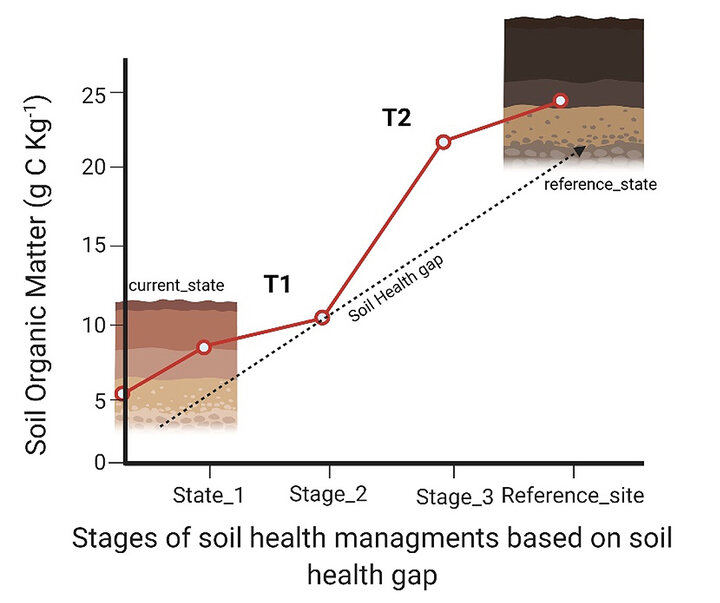Soil Health Gap analysis determines the difference between soil health indicators measured in undisturbed soil supporting a natural, historic climax ecosystem and managed land in a given agroecosystem (Figure 1). An undisturbed soil ecosystem offers a baseline reference comparison of what soil properties would have been if soil supporting new agroecology had been left uncultivated and undisturbed all along.

This gap concept provides an estimation of the potential capacity of a land in terms of ecosystem services. A comparison between the reference and the current state of land will estimate the efficacy of different agronomic management in reclaiming and restoring the potential of the land. Soil Health Gap concept allows addressing specific or multiple soil health indicators with an identified gap as necessary and relevant to objectives for consideration by farmers, conservationists, engineers or economists.
More on the Soil Health Gap can be found in this article.
Mathematically, the Soil Health Gap can be expressed as,
Soil Health Gapx = (SH)n – (SH)m
where, Soil Health Gapx = Soil Health Gap with the subscript “x” indicating a general or specific property, (SH)n and (SH)m refer to soil health in n; native soil and m; managed land.
Soil Health Gap concept was acknowledged in a 2021 World Bank Group guide on an overview of carbon market benefits to help policy makers advance a variety of sustainable development objectives around the world.
The Soil Health Gap concept allows estimating differences of soil health indicator under varying management practices that may have accumulated since cultivation began. Producers with a greater Soil Health Gap would benefit the most from opportunities to grow and support soil health improvements. The greater the Soil Health Gap, the greater the opportunity for positive change in soil health indicators. The Soil Health Gap concept facilitates rapid comparison and the documentation of good land stewardship.
For example, sample collected from different lands in Scotts Bluff County showed an exponential decline in soil organic carbon (SOC), as we moved from grassland (reference) to no-till to conventional till to exposed subsoil (Figure 2). Soil Health Gap in terms of SOC for these lands can be calculated as, Soil Health GapC = 44 – 22 = 22 g C kg−1 for no-till; Soil Health GapC = 44 – 18 = 26 g C kg−1 for conventionally tilled farmland; Soil Health GapC = 44 – 7 = 37 g C kg−1 for subsoil exposed farmland.

As management practices are introduced to enhance SOC in these fields, Soil Health Gap will inform the producers about maximum attainable goals. Producers may set incremental targets to reduce the Soil Health Gap using different agronomic management practices (Figure 3). In the absence of Soil Health Gap measurement, one may under- or over-estimate the soil health target due to a lack of its quantitative measure.
To determine Soil Health Gap, it is critical to locate reference sites and measure soil health status in those sites under the given agroclimatic conditions. It is essential to make the data available so that anyone who assesses their managed lands can compare it against soil health indicators from a relevant reference site to estimate Soil Health Gap for their soil. The Soil Health Gap simultaneously presents a measure of the extent of soil degradation compared to the reference soil and potential future attainable soil health targets for resource conservation management.
It may take several years and a suite of conservation practices to improve soil health and close the Soil Health Gap (Figure 3). Soil Health Gap can also be very instrumental for current carbon offset market in determining carbon additionality and to better estimate the benefits.

In the two-year NRCS-UNL collaborative investigation, we determined a) the landmass classification system to dissect discreet units where land has presumably similar soil health potential using NRCS land classification hierarchical system, b) a minimum number of reference sites required to collect samples in each such land unit, and c) initiated collecting soil samples from a few selected reference sites.
This collaborative effort also initiated the generation of an interactive map for the presentation of all data that have been collected and a plan for more to come. The overarching goal of the collaboration is to have an interactive map where one can locate a reference site (and associated soil health data) relevant to their land and this will allow all of them to estimate a Soil Health Gap. More to follow on the details of the resulting research reports!
